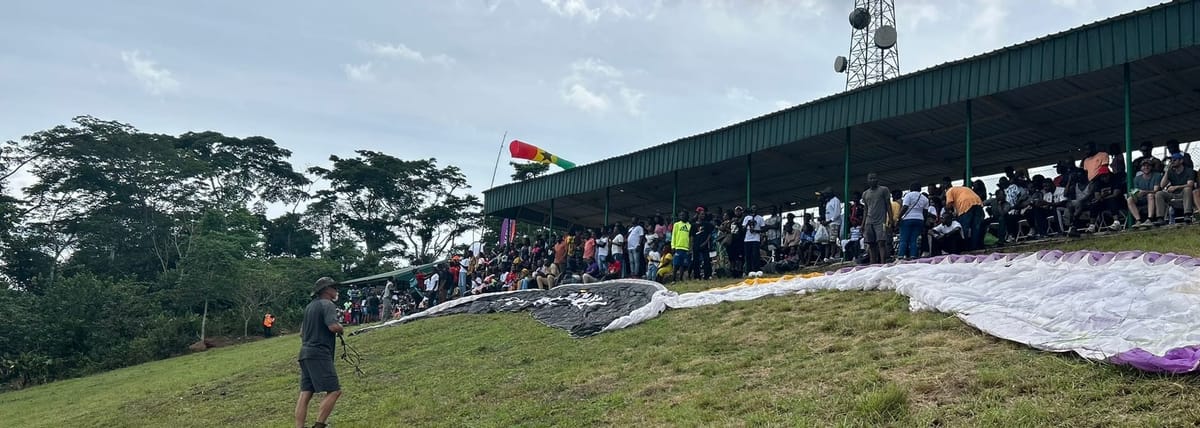The Kwahu Diaries

After my previous write up on the most talked about Kwahu Easter Festival: A Global Homecoming Celebration of Culture, Adventure, and Unity, I knew I had to experience the magic of Kwahu for myself. So I packed my bag, hit the road, and joined the sea of revelers winding up the escarpment toward Ghana’s most iconic mountaintop celebration. But what I found went far beyond paragliders and parties rather I found thrilling, adventurous encounters, and a spiritual connection to the land.
Abetifi – The Highest Habitable Point in Ghana
Standing tall at 2,080 feet above sea level, Abetifi, a town within the Okwahu (Kwahu) enclave of the Eastern Region, is proudly recognized as the highest habitable point in Ghana. This elevated landscape offers a uniquely cool and pleasant climate, averaging 25°C, characteristic of tropical highland environments. Abetifi is one of several Kwahu towns clustered within a four-kilometer radius, each sharing a rich cultural and historical heritage. This strategic location makes Abetifi not only a geographical marvel but also an important hub for tourism, history, and spiritual reflection.
Ramseyer Memorial Presbyterian Church – A Legacy of Faith
Located in the heart of Abetifi is the historic Ramseyer Memorial Presbyterian Church, the second oldest Presbyterian Church in Ghana. It was founded by Basel missionary Fritz Augustus Ramseyer, whose evangelical mission played a crucial role in spreading Christianity across the Kwahu area in the 19th century.
Following his release from captivity in Ashanti, Ramseyer arrived in Abetifi in 1876, where he established a mission station that would later become the Ramseyer Memorial Presbyterian Church. This iconic structure stands not only as a house of worship but also as a monument to the resilience and dedication of early Christian missionaries.
Within the church premises is a memorial monument inscribed with the names of those missionaries, paying tribute to their service and sacrifice. The church also laid the foundation for the establishment of the Ramseyer Training Centre (RTC), which continues to train Christian workers and pastors to this day.
The legacy of Ramseyer and his fellow missionaries is deeply woven into the fabric of Abetifi, making it a sacred destination for pilgrims, historians, and travelers seeking to explore the roots of Ghanaian Christianity.
Abetifi Stone Age Park: Beginning of Civilization

Perched at 2,080 feet above sea level in Ghana’s Eastern Region, Abetifi is best known for its cool climate and sweeping ridge views. Tucked within this high‑altitude town is the Abetifi Stone Age Park, a 52‑acre site that brings visitors face‑to‑face with tools and relics dating back more than 12,500 years.
Local entrepreneur Ben Addo spearheaded the park’s creation, transforming what was once a refuse dump into an open‑air museum. Shaded walkways lead through stands of native grass to Bosompra Cave, where excavations have uncovered broken tortoise shells and finely chipped stone implements which serve as evidence of early humans hunting and preparing food on these very hills.
Inside the cave, you’ll find a shallow pool known as the “Water Mirror.” Archaeologists believe our Stone Age predecessors used its still surface to reflect the sky, check their own faces, or perform simple rituals.
Rather than sealing artifacts behind glass, the park encourages hands‑on discovery. Under the guidance of trained local guides, visitors move from excavation sites to timber‑framed interpretive shelters. Each stop features clear panels that explain both the scientific findings and the local stories that have grown up around them. The result is a living history lesson: one that connects modern travelers with the people who first walked these highlands.
Nkofieho Caves – The Heartbeat of Kwahu Resistance
Tucked into Kwahu’s mist‑shrouded hills is the most emotional yet beautiful Nkofieho Caves. To reach them, one would trek a narrow path, scramble up mossy rocks, and squeeze through limestone walls that whisper stories from centuries past.
These caves weren’t just hiding places rather they were sacred resistance zones. Deep inside, the Kwahu people gathered for yérenoaoko ceremonies, where they prayed with herbs and hope, shielding themselves with ancestral strength during times of war. One would feel goosebumps imagining the soft chants that once filled those echoing chambers.
It’s in this adventure where the story of Otumfuo Osei Tutu I, whose fall into the Pra River near the cave marks a pivotal thread in Ashanti history. The symbolic ritual still performed by Ashanti royals today gave me chills. For someone like me, who straddles both the modern and the traditional, this wasn’t just folklore rather a place to call home
Odweanoma Paragliding Field
On Easter Monday, the grassy slopes of Odweanoma Paragliding Field buzzed with the kind of eager energy that only a holiday steeped in renewal can bring. Since 2005, this ridge‑top launch site has been drawing thrill‑seekers and storytellers alike, and this year was no exception, where over a dozen adventurers, both locals and visitors, were charged ₵1,350 for a tandem flight, lifting their spirits above the mist‑clad valleys and cities of Nkawkaw. I caught up with Jake and Ryan Smith, two brothers from Colorado who’ve spent the last seven months volunteering in Ghana, their eyes alight as they described the moment the wind caught their wings and carried them into the sunrise.
Conclusion
The Kwahu Easter celebration is not just a celebration but a special occasion for all, and the experience would be worth the visit and the penny spent.
The Equatorial Gulf is an independent group of writers dedicated to insightful analysis and thought-provoking discussions on global and regional topics.
Comments ()